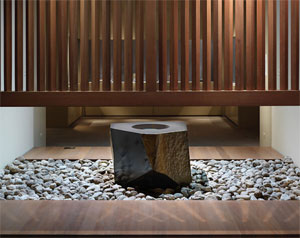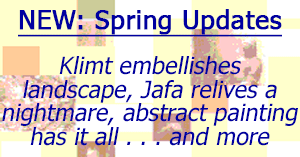4.7.25 — A Buddha Nature
Does a dog have a Buddha nature? A Zen master’s no was brief and clear, but then who knows what else a dog might smell on a street near you?
Then, too, nothing is unequivocal in a koan—or in a thousand years of Japanese art from the Mary and Cheney Cowles collection at the Met. Its real and promised gifts are substantial enough to fill ten rooms off the museum’s Asian wing and its Chinese art, space enough to give a folding screen, a book, or a single scroll an alcove to itself.  Sculpture alone could make you feel that you have entered a darkened temple or a tea house, with nowhere to stand apart from its guardians. An arrangement without regard for chronology may make you wonder if anything has changed or can ever change, until, that is, you stumble onto the present.
Sculpture alone could make you feel that you have entered a darkened temple or a tea house, with nowhere to stand apart from its guardians. An arrangement without regard for chronology may make you wonder if anything has changed or can ever change, until, that is, you stumble onto the present.
The show opened just days after a rehanging of the galleries for Chinese art right next door, to feature painting and calligraphy—often as not meaning poetry, and I work this together with my earlier report on that art as a longer review and my latest upload. And the show’s title promises to separate the three, as “The Three Perfections,” through August 3. Yet nobody’s perfect, and the Japanese insist on it. Think of Buddhism as the way to peace? Here the very first sculpture, a god, bears a sword to protect enlightenment from the likes of you. Another deity has a “wisdom fist.” And yet wisdom itself cannot transcend human imperfections, for all its resounding no.
Seekers of enlightenment still debate Zhaozhou’s no. For the Met, no means no, but could the Zen master have meant only the common image of a dog as a lowly creature? For a believer, everything in this world has a Buddha nature, and a dog has only to realize it. No wonder the sternest of guardians have a wider nature. In statues, the gods frown, but their robes flow freely, and gold enhances every fold. Nothing here is immune to delight, where even a stone for the artist’s ink may bear gilding.
Zhaozhou himself says nothing in what I hesitate to call a portrait in the Cowles collection, nine hundred years after his death. In a screen to his left, a bird rests on a tree looking gloriously upward. To the right, more lowly birds seem almost comic figures—but then the sage looks eccentric, too, with his scraggly beard and a knife, perhaps a writer’s tool, fallen to the ground. Here no means yes, and yes means yes to the world you know. Chinese art flaunts its connection to the past, with reverence. Here everything enters the present.
A black stone fountain, set on white pebbles, conveys a felt peace and physical motion that even the ancients rarely knew. It is not a recreation of a long-ago tea garden, but sculpture by Isamu Noguchi from the Met’s modern wing. Calligraphy itself looks to the past for an artist’s present impulse. Japan adopted Chinese writing for a phonetic alphabet of less detailed, freer marks, and an artist had to learn both. Wall text displays a poem as thirteen Chinese characters and again phonetically, from the Japanese, as two full lines. But then, as a translation has it, “our joy is limitless.”
The Japanese writing system may appear separately, in graceful curves or as little as three letters and a spot of ink. Or the systems may blend into one another and into realism. Those curves adapt easily to stones, streams, and flowers. A single scroll may combine writing, patterning, and flowers. One god rests on a lotus, where attendants bring their presences and shadows as well. Who needs another wooden god with eleven heads?
When China enters the eighteenth century, its nods to the West speak of an empire’s decline. Japanese art is just getting going. A scroll of “immortal poets” gives them individuality and a sense of humor that Chinese art never felt. A growing emphasis on color allows trapezoids that add perspective, although not Europe’s linear perspective. It also allows a story, like the eleventh-century Tale of Genji, to unfold in an enormous folding screen. Like views of Edo from Hiroshige, at the Brooklyn Museum, it could take place in a far older landscape or in Tokyo today.
 Noguchi himself invites contemplation of both past and present. Water Stone could be a found object or painstaking carving, with an eye at once to tradition, Modernism, and Minimalism. Water from this fountain does not spout up but rather ripples off the black tabletop onto white stone. A blond wood screen descends to maybe shoulder height. It sets the space of the ceremony apart from the viewer, who can nonetheless linger and belong. The work presents a complementary view from the other side, obliging a second encounter after a prolonged exposure to Japanese art.
Noguchi himself invites contemplation of both past and present. Water Stone could be a found object or painstaking carving, with an eye at once to tradition, Modernism, and Minimalism. Water from this fountain does not spout up but rather ripples off the black tabletop onto white stone. A blond wood screen descends to maybe shoulder height. It sets the space of the ceremony apart from the viewer, who can nonetheless linger and belong. The work presents a complementary view from the other side, obliging a second encounter after a prolonged exposure to Japanese art.
I shall never get over my suspicion of a museum’s catering to collectors in exchange for gifts. I cannot easily explain this show’s arrangement—or a title that its wealth of materials hastens to ignore. It also includes a glass deer from Kohei Nawa in 2011, an oversized paperweight that I should just as soon had never appeared. Then, too, there is no challenging Chinese painting, calligraphy, and poetry. That is why Japan took it as a model. Still, neither is there challenging Japan’s thoughts of transcendence and its all-too-human refusal.
Read more, now in a feature-length article on this site.